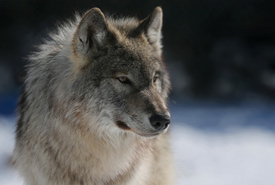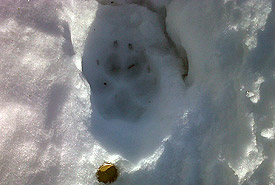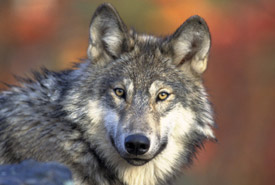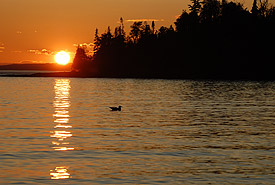A soft spot for the infamous predator: Wolves

Gray wolf (Photo by Mike Dembeck)
The timber wolf, also known as the gray wolf, is common in northwestern Ontario, where I have worked and lived for nearly 40 years.
Common, but not always safe.
I have a soft spot for predators such as wolves. In part because they are beautiful and intelligent animals and in part due to the troubled relationship humans have with wolves. Humans have had a long and complicated relationship with wolves, one which continues today. Wolf “culls” are ongoing or proposed across much of their range, perhaps due to the unwarranted fear they instill in humans.
But as the top predator in the northern boreal forest, wolves are an essential part of a healthy ecosystem.

Wolf track (Photo by NCC)
Whether I catch a glimpse of a wolf on the side of the highway, perhaps feeding on a road-killed moose or deer, or as I come around a corner on a trail and come face-to-face with one, it is always a special experience to see one. A fresh track in newly fallen snow is often the only evidence of a wolf having been there just a moment before. This always raises the hair on the back of my neck, and I often wonder if the wolf is watching me at that very instant.

Grey wolf (Photo by Gary Kramer, courtesy of USFWS)
Despite having only ever captured a few pictures of wolves, I have many memories of them.
Perhaps my most intense relationship with wolves came when I was raising sheep for the better part of 15 years on our family farm just outside Thunder Bay, Ontario. Raising any livestock in an area with wolves, along with predators such as black bears and coyotes, is a challenge. We knew going into farming that predators would be a real threat to our livestock. I had heard from many farmers over the years about their experiences of losing animals to wolves. Farmers have learned to coexist with these predators, and I have learned from their experiences. Adequate fencing and keeping the sheep in the barn at night ensured that our sheep were never the victims of a wolf attack.
That said, I was always thankful to see a wolf during those farming years, as long as it was on the right side of the fence.
I can’t imagine the northern Ontario landscape without wolves. They are powerful, beautiful animals. It is always a privilege to see one, no matter how brief the encounter.
The wolf is one of nine species featured in NCC’s gift-giving campaign: Gifts of Canadian Nature. To learn more and to give the gift of conservation this holiday season, click here.


